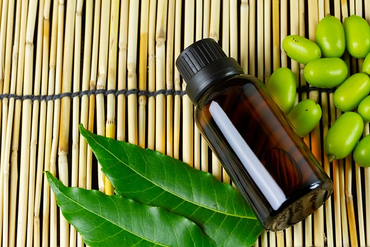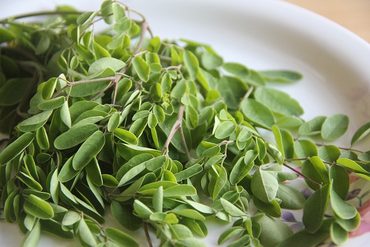
Applying body oil is a simple yet nourishing skincare step that can transform your body care routine. Body oil is rich in essential nutrients and moisturizing properties, making it a vital step for maintaining healthy, glowing skin. Whether you're looking to lock in hydration, enhance your skin's texture, or simply indulge in a moment of self-care, understanding the proper way to apply body oil can make all the difference.
So below, we’ve covered the how-to's of making the most of this luxurious product.

Applying body oil is a soothing and beneficial practice that can elevate your skincare routine. Here’s how you can do it effectively:
It is important that you start from a clean base, so take a shower or bath to remove any dirt, sweat, and impurities from your skin. This ensures that the body oil can penetrate more effectively and work its magic.
After cleansing, pat your skin lightly with a towel, leaving it slightly damp. Applying body oil to damp skin helps lock in moisture and enhances absorption.
Pour a small amount of body oil into the palm of your hands and rub them together to warm the oil slightly. This warming step not only makes the oil feel more luxurious but also helps it spread more easily across your skin.
Start with a small amount of oil and apply it to your body in sections. Use long, sweeping motions to distribute the oil evenly. Begin at your legs and work your way up to your torso, arms, and shoulders. This method ensures that every part of your body receives the hydrating benefits of the oil.
Gently massage the oil into your skin using circular motions. Don’t rush—this step is important for helping the oil absorb and for boosting blood circulation, plus it’s very relaxing. Pay extra attention to particularly dry areas like your elbows, knees, and heels.
Let the oil absorb into your skin for a few minutes before getting dressed. If you're in a rush, you can blot any excess oil with a clean towel to prevent staining your clothes.
Timing is crucial when it comes to applying body oil. Here are the best moments to incorporate body oil into your skin care routine:
Apply immediately while skin is still damp for better absorption
Nightly application allows for deep moisturizing during sleep
Oil penetrates more effectively on freshly exfoliated skin
Enhances the massage experience and provides deep moisturization
More frequent application to combat dry, cold weather
Helps maintain skin hydration, especially during air travel
Soothes and rehydrates skin after sun exposure
Incorporating body oil into your body care routine offers numerous benefits:
Body oils are excellent for providing intense hydration. Unlike lotions, oils penetrate deeper into the skin, ensuring long-lasting moisture. This makes them especially beneficial for those with dry or dehydrated skin, as they help to replenish and retain the skin's natural moisture levels. A study published in the International Journal of Cosmetic Science found that certain plant oils can significantly improve skin hydration.

Regular use of body oil can transform the texture of your skin, making it noticeably softer and smoother. The oils work to smooth out rough patches and improve the overall feel of your skin, providing a silky, velvety finish. Research in the Journal of Clinical and Aesthetic Dermatology suggests that emollient oils can improve skin barrier function and texture.
Body oils can enhance your skin’s natural glow, giving it a healthy and radiant appearance. The oils help to reflect light, making your skin look more luminous and vibrant, which is perfect for achieving a youthful and healthy look.
Rich in vitamins, antioxidants, and essential fatty acids, body oils nourish the skin deeply. Ingredients such as Vitamin E, Omega-3, and Omega-6 fatty acids help to repair and rejuvenate the skin, promoting cell regeneration and improving the skin’s overall health and resilience.
Body oils create a protective barrier on the skin, which helps to shield it from environmental damage. This barrier protects against pollutants, harsh weather conditions, and other external factors that can cause dryness, irritated skin, and premature aging.
Massaging body oil into your skin can stimulate blood circulation, which promotes healthier skin. Improved circulation helps to deliver more oxygen and nutrients to the skin cells, enhancing the skin’s overall tone and vitality. A study in the Journal of Physical Therapy Science found that massage with oil can improve blood circulation.
By understanding how to use body oil correctly and incorporating it into your body care routine at the right times, you can enjoy all these benefits and more. In the following sections, we'll delve deeper into choosing the right body oil for your skin type and debunk common myths about using body oils.

To provide you with well-rounded information, we've gathered insights from skincare experts on the benefits and proper use of body oils:
If you haven’t used a body oil before, here’s a tip from board-certified dermatologist Dr. Connie Yang of PFRANKMD by Dr. Paul Jarrod Frank: It works best when applied to semi-damp skin immediately after a shower or bath. This technique allows the oil to act as a seal, which prevents your skin barrier from losing the water it needs to function.
Dr. Elizabeth Hale, NYC-based board-certified dermatologist, emphasizes that “people with skin dry complex may prefer a body oil over a lotion, as oils provide moisturization and create a protective barrier to help minimize transepidermal water loss. From an aesthetic perspective, oils often leave more sheen on the skin compared to lotions and creams, which many people prefer.”
Body oil is a concentrated blend of nourishing oils designed to moisturize and protect your skin. Unlike applying body lotion or a cream that contains water as a primary ingredient, body oils are pure, nutrient-rich formulations that closely mimic the natural oils in our skin. This allows them to be readily absorbed, providing deep hydration without leaving a greasy residue.

Body oils come in various formulations, typically consisting of:
Carrier oils: These form the base of most body oils. Common examples include coconut oil, jojoba oil, and sweet almond oil. Each has unique properties beneficial for the skin.
Essential oils: Often added for their aromatic and therapeutic properties, any essential oil like lavender, chamomile, or citrus oils can enhance the overall experience of using body oil.
Selecting the appropriate body oil can significantly impact its effectiveness. Consider your skin type when choosing:
| Skin Type | Recommended Oils |
|---|---|
| Dry skin | Avocado, Argan |
| Oily/combination skin | Grapeseed, Jojoba |
| Sensitive skin | Chamomile, Calendula |
| Acne-prone skin | Hemp seed, Safflower |
❌ Myth: "Oil clogs pores"
✅ Truth: Many natural oils are non-comedogenic
❌ Myth: "Body oil is only for dry skin"
✅ Truth: All skin types can benefit from body oils
❌ Myth: "Body oil leaves a greasy residue"
✅ Truth: When applied correctly, body oils absorb quickly
Let's address some common misconceptions about body oils:
Myth: "Oil clogs pores" Truth: Many natural oils are non-comedogenic and won't clog pores. In fact, some can help balance the skin's oil production.
Myth: "Body oil is only for dry skin" Truth: All skin types can benefit from body oils. The key is choosing the right type for your skin.
Myth: "Body oil leaves a greasy residue" Truth: When applied correctly to damp skin, body oils absorb quickly without leaving a greasy feel.
Shankara offers a range of high-quality body oils to suit various needs:
Key ingredients: Arnica, sweet birch oil, and boswellia
Body Oil Benefits: Soothes sore muscles, reduces inflammation, enhances relaxation
Usage: Ideal for post-workout recovery or deep tissue massage
Key ingredients: Lavender, calendula, and lemon balm
Body Oil Benefits: Deeply hydrating, calming for sensitive skin
Usage: Perfect as a daily moisturizer, massage oil, or bath oil
Key ingredients: Dashmoola, vetiver, and borage
Body Oil Benefits: Intense moisturization, rich in nutrients and antioxidants
Usage: Excellent for stress relief and promoting overall skin health
While body oils are generally safe, it's important to be aware of potential allergies:
Common allergens in body oils include nut oils (like almond or macadamia) and essential oils.
Always perform a patch test before using a new body oil. Apply a small amount to your inner wrist and wait 24 hours to check for any adverse reactions.
Yes, applying body oil to your entire body is good for moisturizing, nourishing, and improving skin tone. It can also provide relaxation during massages and leave a pleasant fragrance. Apply on damp skin after a shower for best results.
Yes, body oil and lotion can in fact be used interchangeably. Body oil can be a great alternative to lotion. It moisturizes and nourishes your skin just like lotion does, but it often feels lighter and less greasy. It's particularly good for dry or sensitive skin, leaving it smooth and glowing.
It's generally recommended to apply body oil after using body wash. Body wash cleanses the skin, removing dirt and impurities, while applying body oil afterwards helps to lock in moisture, promoting skin hydration and smooth skin.
No, body oil is not designed to be used as a body wash. Body oils are intended for moisturizing and hydrating the skin after cleansing. Using body oil as a body wash would not effectively clean the skin, as oils do not contain surfactants needed to remove dirt and impurities. It's best to use body oil after bathing or showering, on damp skin, to lock in moisture and provide hydration. For cleansing purposes, use a product specifically formulated as a body wash or cleanser.













comments (0)